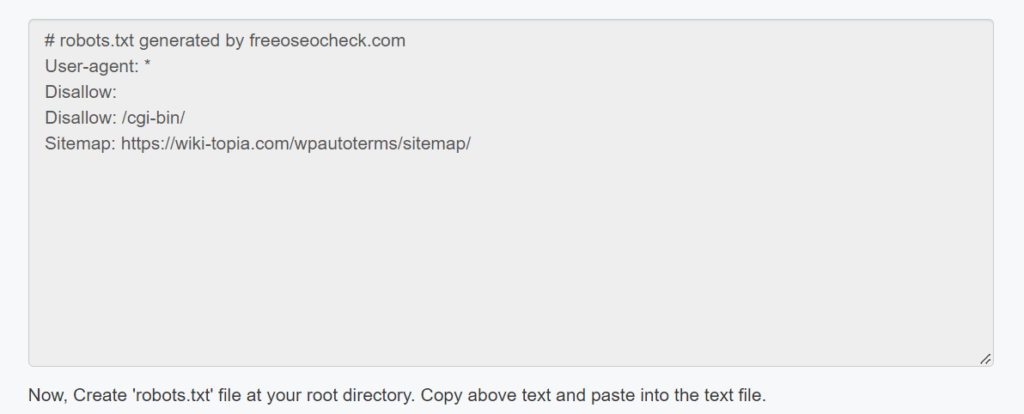Contents
About Robots.txt Generator
You can generate Robots.txt by accessing the next link.
You can optional include your sitemap and allow/refused most known search robots like google,yahoo..
After that something like this should appear.

Overview of Our Online Robots.txt Generator
Our Robots.txt Generator tool is designed to help webmasters, SEOs, and marketers generate their robots.txt files without a lot of technical knowledge. Please be careful though, as creating your robots.txt file can have a significant impact on Google being able to access your website, whether it is built on WordPress or another CMS.
Although our tool is straightforward to use, we would suggest you familiarize yourself with Google’s instructions before using it. This is because incorrect implementation can lead to search engines like Google being unable to crawl critical pages on your site or even your entire domain, which can very negatively impact your SEO.
Let’s delve into some of the features that our online Robots.txt Generator provides.
How to Create Your Robots.txt File
How can you create your first robots.txt file?
The first option you’ll be presented with is to allow or disallow all web crawlers to access your website. This menu allows you to decide whether you want your website to be crawled; however, there may be reasons why you might choose not to have your website indexed by Google.
The second option you’ll see is whether to add your xml sitemap file. Simply enter its location within this field. (If you need to generate an XML sitemap, you can use our free tool.)
Finally, you’re given the option to block certain pages or directories from being indexed by search engines. This is typically done for pages that don’t provide any useful information to Google and users, such as login, cart, and parameter pages.
When it is done, you can download the text file.
After you have generated your robots.txt file, make sure to upload it into the root directory of your domain. For example, your robots.txt file should appear at: www.yourdomain.com/robots.txt
Sound useful? We hope so!
Generate your first robots.txt file with our tool and let us know how it works for you.
What Is a Robots.txt File?
A robots.txt file is a really simple, plain text format file. Its core function is to prevent certain search engine crawlers like Google from crawling and indexing content on a website for SEO.
If you’re not certain whether your website or your client’s website has a robots.txt file, it’s easy to check:
Simply type yourdomain.com/robots.txt. You’ll either find an error page or a simple format page. If you are using WordPress and you have Yoast installed, then Yoast can also build the text file for you as well.
More on Robots.txt Files
Some advanced phrases you may find within your robots.txt file include:
User-agent:
Since each search engine has its own crawler (the most common being Googlebot), the ‘user-agent’ allows you to notify certain search engines that the following set of instructions is for them.
You’ll commonly find ‘user-agent’ followed by a *, otherwise known as a wildcard. This indicates that all search engines should take note of the next set of instructions.There is also typically a default phrase following the wildcard that tells all search engines not to index any webpage on your site.
The default phrase is to disallow the symbol ‘/’ from being indexed, which essentially prohibits every internal page except your main URL from the bots. It’s important that you check for this phrase and immediately remove it from your robots.txt page.
It will look something like this:
User-agent: *
Disallow: /
Disallow:
The term ‘Disallow’ followed by a URL slug of any kind gives strict instructions to the aforementioned user-agent, which should appear on the line above.
For instance, you’re able to block certain pages from search engines that you feel are of no use to users. These commonly include WordPress login pages or cart pages, which is generally why you see the following lines of text within the robots.txt files of WordPress sites:
User-agent: *
Disallow: /wp-admin/
XML Sitemap:
Another phrase you may see is a reference to the location of your xml sitemap file. This is usually placed as the last line of your robots.txt file, and it indicates to search engines where your sitemap is located. Including this makes for easier crawling and indexing.
You’re able to make this optimization to your own website by entering the following simple function:
Sitemap: yourdomain.com/sitemap.xml (or the exact URL of your xml sitemap file).

